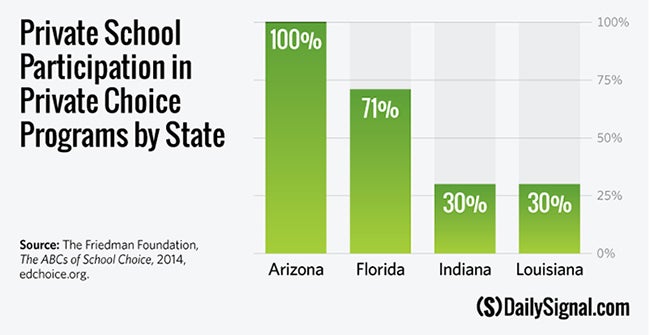School Choice Regulation: Be Careful What You Wish For
Matthew Ladner /
Attempts to overly regulate private schools participating in school choice programs have a funny way of behaving.
We have tried very different approaches to testing across private school choice programs. If we are to make full use of the laboratories of democracy, we must assess the results of new policies as a part of a decentralized learning process. One of the clear recent lessons from the states is that regulation of private schools leads to fewer private school seats made available to children.
Information regarding the number of participating private schools is not available for all programs. Some programs have geographical limitations (voucher programs focused on a single city, for instance), focus on a very narrow student population (students with special needs, for instance), or are either too new or too small to facilitate a broad comparison.
The Arizona scholarship tax credit, the Florida Corporate Tax Credit scholarship program, and the Indiana and Louisiana voucher programs, however, have the necessary data and scale to facilitate a meaningful comparison:
- Arizona’s scholarship tax credit program entails financial accountability for scholarship organizations that manage and distribute scholarships, but it takes a hands-off approach to participating private schools. Arizona private schools typically test their students with national norm-referenced exams such as the Stanford 10, but the choice statute does not require them to do so. Some schools make their scores public, most others make them available on request, but the state makes no systematic collection of academic data.
- Indiana and Louisiana require private schools to take the state test used to hold public schools accountable. The laws go further in grading schools A–F just as they do for the public schools. Moreover, both states can remove low-graded schools from participating in the voucher program.
- Florida’s Corporate Tax Credit scholarship program requires testing of scholarship recipients and allows the school to choose the test used. The data are then analyzed and reported in the aggregate. This approach is a middle ground between Arizona’s hands-off approach and that adopted by Indiana and Louisiana.
Some view the Indiana and Louisiana laws as a near ideal that ought to be replicated in future programs. Note, however, that this degree of regulation comes with an obvious and self-defeating cost: Many private schools remain outside the program.
Private choice programs should provide as many options as possible to parents. States with choice programs in which 70 percent of private schools choose not to participate do not deliver adequately robust school choice options. In fact, when only 30 percent of private schools choose to participate, financially desperate private schools may be over-represented among the participating schools. Likewise, more solid operations may be over-represented among the non-participants. In a sad bit of ironic backfire, provisions intended to raise the average quality of available seats may have in fact lowered both the quantity and average quality of available seats.
Honest people can disagree as to whether the Arizona or Florida model represents a preferable model. Florida’s program has lower participation but higher transparency and has developed far more bipartisan support. Choice advocates should, however, avoid the Indiana/Louisiana school testing model.
Matthew Ladner, PhD, is the senior advisor of policy and research for the Foundation for Excellence in Education.

